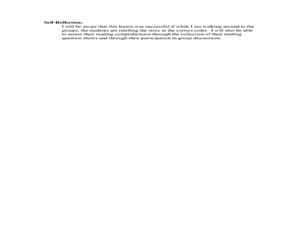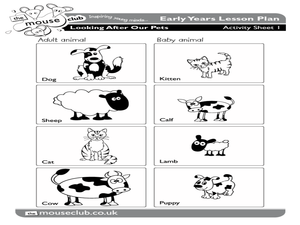Hawaiʻi State Department of Education
Puppet Scenes
Explore character, plot, and setting through dramatic puppet play. Second graders discuss basic story elements and then practice making a character with their sock puppets. After they've crafted a dynamic puppet, they pair up to create a...
Curated OER
Puppet Show
Students create a puppet show for a play. They choose the puppet characters they wish to enact the play and develop scenarios.
Curated OER
Ehhh...What'd you say?
Practice pronouncing and spelling words with the /e/ sound with spellers. They blend phonemes with spelling maps to master important representation and letter symbol of the short vowel /e/. They also make sock puppets and study the...
Curated OER
Everyday Life in Africa
Students read story Not So Fast Songololo by Niki Daly, compare life of a boy in Africa with their own lives, create sock puppets, and act out stories that they have written in groups.
Curated OER
The Very Hungry Caterpillar Puppet Book
First graders create their own puppet book to go with "The Very Hungry Caterpillar" book.
English Enhanced Scope and Sequence
Identifying Synonyms
"Let the hunt begin!" As an introduction to synonyms, second graders generate a list of word pairs that have similar meanings. The words pairs are written on sentence strips, cut apart, shuffled, and distributed to class members who must...
Curated OER
Counting Crows
Students discuss the fable, The Crow and the Pitcher. In this literature lesson, students read the fable and create a crow sock puppet. Students use their puppets to dramatize the fable.
Curated OER
Relative Size - Wide and Narrow
Students distinguish between wide and narrow manipulatives and sort accordingly. They use construction paper strips, ribbon, fabric strips, books, popsicle sticks and sock puppets.
Curated OER
The Little Hungry Caterpillar
Students discuss "The Little Hungry Caterpillar." In this reading comprehension lesson, students make sock caterpillars used in retelling the story so as sequence the events accurately.
Curated OER
Puppets 'n' Plays
Students reinforce communication skills, create the puppets, write or improvise dialog for them, and put on a play.
Pennsylvania Department of Education
Speaking Skills
Students listen to The Hungry Caterpillar by Eric Carle and use a teacher created puppet for a listening activity. In this Hungry Caterpillar lesson, students recall the order of events in the story with the puppet and cards of the...
Curated OER
Phoneme Segmentation
Students practice counting the number of sounds in names and words through the use of a ninja puppet that chops the sounds. The emphasis is on the breaking up of the names with the use of karate chops to increase student participation.
Curated OER
Being Brave and Dealing with Fear
Students discuss fears. In this bravery lesson, students listen to the book Brave Little Monster by Ken Baker and discuss the monster's fears. They create puppets of themselves being brave.
Curated OER
We Are Super-Duper!
Pupils explore the concept that each person is unique, special and valuable and assess how to express that concept with positive attitudes through role play, music and art. They email a friend or family member a special message with a...
Curated OER
"Let's Write a Song"
Fourth graders brainstorm ideas that answer the question, "What is a song?" They determine the parts of a song, read lyrics, and listen to a song while identifying the chorus. They repeat the procedure with a new song before working in...
Curated OER
Toys then and Now
Third graders read poems by Paul Lawrence dunbar desling with toys and examine how they have changed. They make their own toys, using socks for puppets and drums from boxes.
Curated OER
Double Jeopardy-Homophones
Second graders identify homophones as words that sound alike but have different meanings. They, given a pair of homophones, are to explain the meanings of the words using gestures, role playing, or drawing a picture with their partner.
Florida Center for Reading Research
Phonological Awareness: Syllables, Syllable Say
Counting syllables can be fun when it's done with a friend. In pairs, learners say words as their partner counts the syllables they hear.
Curated OER
T Letter Ideas
Pupils participate in activities that begin with the letter "T". They also expand their vocabulary.
Curated OER
Looking After Our Pets
Students explore animal lifestyles by illustrating images. In this pet care lesson, students discuss their own pets and the conditions animals need to survive in both nature or a home. Students draw snakes and complete an activity sheet...
Curated OER
Word Choice: Lose and Loose
In this word choice activity, students fill in blanks in a set of 20 sentences with the appropriate choice: lose or loose. Online version link available.
Curated OER
Everyday Life In Africa
Students compare the life of a boy in Africa with their own lives. Students act out stories that they have written in groups.
Curated OER
Natural Enemies
Fourth graders engage in the reading of an ancient Chinese fairy tale. The goal of the lesson is for them to become creative in the use of writing. The story creates a context for student's writing and ideas for future drafts.
Curated OER
Japanese Folktales
Students listen to examples of Japanese folktales and identify universal themes. Students construct a 'kamishibai' - a traditional Japanese storytelling prop - and dramatize a folktale through puppetry.
Other popular searches
- Sock Puppets Lesson Plan
- Making Sock Puppets
- Sock Puppets and Math
- Art Sock Puppets
- Farm Animal Sock Puppets
- Sock Puppets History
- Lesson Plans Sock Puppets
- Camel Sock Puppets

























